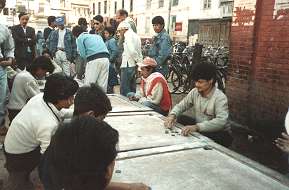History of Carrom
Carrom as we know it today has been played for nearly two hundred years, although games of a very similar nature have been played for thousands of years under a variety of names. Some believe it originated in India, while others link its origins to Portugal and even Burma. Carrom is spelt in many ways, including carom, carum, karom and kairam; One may find this confusing, but it simply reinforces an underlying trend and nature of this game, where tradition and history reveal variety and differences. The history of thought and the history of carrom preceded the written word and we therefore have no record of it. The game lives through play, not necessarily dependent upon words.

Although no one knows when the first game of carrom was played in the style with which we are now familiar, we seem to know when the word carrom entered into usage. The word “carrom” probably originates in Timor in south east Asia. From there, it travelled with the Portuguese who found it to be a convenient description for the Malabar coast of India. It is also the name of a particularly delicious fruit (star fruit) and by the late eighteenth century, the English speaking world was familiar with the word in the context of the game of “carrom billiards”, a game played on a snooker type table without pockets. A little more time passes and the word “carrom” becomes prominent in English usage, thanks to the growing popularity of billiards, to mean “hitting one thing on to another”. More time passes, and the word “carrom” becomes the now more familiar “canon” in English usage . By the time “canon” was in usage in English ,”carom” was becoming the standard name for a variety of games that form the basis of the contemporary form of the game.
It is clear that the recent history of carrom involves the Portuguese. They may not be solely responsible although they are being remembered as responsible. Just as in the same way Aristotle is remembered for the books which did survive and not for the other works which did not. Concerning karom, we have to credit the Portuguese if for no other reason than they are responsible for the existence of the word carrom and because they are the people to whom the history books point.
Carrom is an ancient game that has survived into the modern world because it is easily adapted to suit the existing circumstances. Tolerance for different styles of play is the very heart of the success of the game. It is and always has been a game played by simple folk, for simple pleasures. Games are part of living culture, something that has been recognised by games commentators over the centuries. Like language, they are adopted from other countries, or brought in by travellers and adapted to suit. This is the nature of language, it is the nature of games and it is the nature of human culture. The present knowledge we have of the game of carrom holds its own clues: it is played differently in different parts of the world and even called different names. People who know the game have a remarkable store of sources and origins for the game, all of which differ and contradict each other.
Part of the process of games is to teach. Either someone teaches you, you teach someone else or the game teaches you. This can happen on many levels. One of the broader parameters of this notion is connected to the history and background of the game and its generalities. The potential to learn from these is manifold. Carrom does not comply with all the rules of form that many of us have learnt to expect from games. If you learn one tradition you will certainly encounter others.
Carrom is considered an oriental game and touched with the charm of things from the east. Either because it is an oriental game, or because it is played by orientals, but more likely because it is played by so many different cultures, carrom at first seems without certain form, without fixed rules. Anyone who claims that their tradition is the only tradition does a disservice to the game and to the generations of cultures who in their own individual and unique ways have developed forms, styles and traditions that continue to be borrowed, adapted and adopted. Carrom is simple: it is the development of a very early game played by our oldest ancestors and given a certain form. Because this form has been given by thousands of different people over the centuries there is no certain form, just a collection of different forms.
Speaking to one native of China, it was amazing to learn that “everyone in Hong Kong and China plays carrom”. It was surprising because our usual contact with the Chinese (in the form of chefs, acupuncturists and herbalists) discloses very limited knowledge of the game. Interestingly, the Chinese describe the game of carrom with three Chinese characters that roughly translate as “a healthy game.” For a game to earn such a label from the Chinese is indeed a special affair.
Thanks for information
Carrom is a favorite past time across Indian cities, towns and villages.
During summer holidays it is not uncommon to see school children playing carrom.
Almost every home in India has a carrom board.
Competitive carrom has been played in India for a long time.